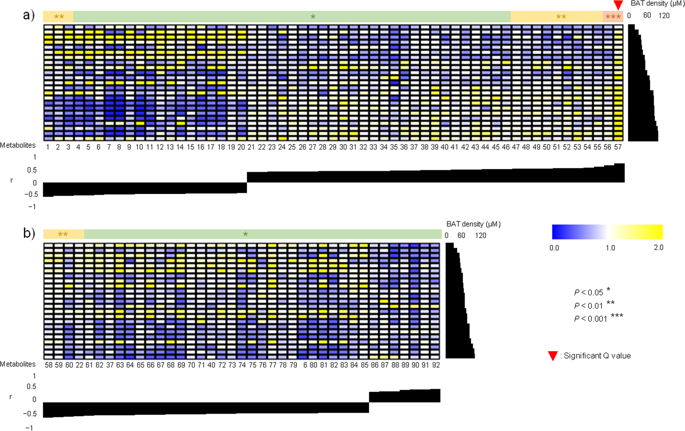当前位置:
X-MOL 学术
›
Int. J. Obesity
›
论文详情
Our official English website, www.x-mol.net, welcomes your
feedback! (Note: you will need to create a separate account there.)
Relationships between plasma lipidomic profiles and brown adipose tissue density in humans.
International Journal of Obesity ( IF 4.2 ) Pub Date : 2020-03-03 , DOI: 10.1038/s41366-020-0558-y Sayuri Fuse 1 , Masahiro Sugimoto 2 , Yuko Kurosawa 1 , Miyuki Kuroiwa 1 , Yasuko Aita 2 , Atsumi Tomita 2 , Eri Yamaguchi 2 , Riki Tanaka 1 , Tasuki Endo 1 , Ryotaro Kime 1 , Takafumi Hamaoka 1, 2
International Journal of Obesity ( IF 4.2 ) Pub Date : 2020-03-03 , DOI: 10.1038/s41366-020-0558-y Sayuri Fuse 1 , Masahiro Sugimoto 2 , Yuko Kurosawa 1 , Miyuki Kuroiwa 1 , Yasuko Aita 2 , Atsumi Tomita 2 , Eri Yamaguchi 2 , Riki Tanaka 1 , Tasuki Endo 1 , Ryotaro Kime 1 , Takafumi Hamaoka 1, 2
Affiliation

|
BACKGROUND/OBJECTIVES
The thermogenic function of brown adipose tissue (BAT) is generally activated in winter and tightly regulated through various metabolic processes. However, the mechanisms mediating these changes have not been elucidated in humans. Here, we investigated the relationships between BAT density (BAT-d) and lipid metabolites in plasma from men and women in the winter and summer.
SUBJECTS/METHODS
In total, 92 plasma samples were obtained from 23 men and 23 women, aged 21-55 years, on two different occasions (summer and winter). Lipid metabolites were comprehensively quantified using liquid chromatography-time-of-flight-mass spectrometry. BAT-d was evaluated by measuring total hemoglobin concentrations in the supraclavicular region using near-infrared time-resolved spectroscopy. Anthropometric parameters, such as the percentage of whole body fat and visceral fat area (VFA), were evaluated. Factors influencing BAT-d were investigated by univariate and multivariate regression analyses.
RESULTS
A variety of metabolite peaks, such as glycerophospholipids (168 peaks), steroids and derivatives (78 peaks), fatty acyls (62 peaks), and glycerolipids (31 peaks), were detected. Univariate regression analysis, corrected by false discovery rate to yield Q values, revealed significant correlations in BAT-d and phosphatidylethanolamine (PE(46:2), r = 0.62, Q = 4.9 × 10-2) in the summer, androgens (r = 0.75, Q = 7.0 × 10-3) in the winter, and diacylglycerol (DG(36:1), r = -0.68, Q = 4.9 × 10-2) in the summer in men, but not in women. Multivariate regression analysis in the winter revealed a significant correlation between BAT-d and plasma androgens (P = 5.3 × 10-5) in men and between BAT-d and VFA (P = 2.2 × 10-3) in women.
CONCLUSIONS
Certain lipids in plasma showed unique correlations with BAT-d depending on sex and season. BAT-d showed a specific correlation with plasma androgens in men in the winter.
中文翻译:

血浆脂质组学特征与人类棕色脂肪组织密度之间的关系。
背景/目的 棕色脂肪组织 (BAT) 的产热功能通常在冬季被激活,并通过各种代谢过程受到严格调节。然而,在人类中尚未阐明介导这些变化的机制。在这里,我们研究了冬季和夏季男性和女性血浆中 BAT 密度 (BAT-d) 与脂质代谢物之间的关系。对象/方法 在两个不同的场合(夏季和冬季),总共从 23 名男性和 23 名女性身上采集了 92 份血浆样本,年龄在 21-55 岁之间。使用液相色谱-飞行时间-质谱法对脂质代谢物进行全面定量。通过使用近红外时间分辨光谱测量锁骨上区域的总血红蛋白浓度来评估 BAT-d。人体测量参数,例如全身脂肪百分比和内脏脂肪面积(VFA),进行了评估。通过单变量和多变量回归分析研究了影响 BAT-d 的因素。结果 检测到多种代谢物峰,如甘油磷脂(168 个峰)、类固醇及其衍生物(78 个峰)、脂肪酰基(62 个峰)和甘油脂(31 个峰)。单变量回归分析,通过错误发现率校正以产生 Q 值,显示夏季 BAT-d 和磷脂酰乙醇胺(PE(46:2),r = 0.62,Q = 4.9 × 10-2),雄激素(r = 0.75, Q = 7.0 × 10-3) 在冬季,男性的甘油二酯(DG(36:1), r = -0.68, Q = 4.9 × 10-2),女性则不然。冬季的多变量回归分析显示 BAT-d 与血浆雄激素之间存在显着相关性(P = 5. 3 × 10-5) 在男性中,在 BAT-d 和 VFA 之间 (P = 2.2 × 10-3) 在女性中。结论血浆中的某些脂质与 BAT-d 显示出独特的相关性,具体取决于性别和季节。BAT-d 显示出与冬季男性血浆雄激素的特定相关性。
更新日期:2020-04-24
中文翻译:

血浆脂质组学特征与人类棕色脂肪组织密度之间的关系。
背景/目的 棕色脂肪组织 (BAT) 的产热功能通常在冬季被激活,并通过各种代谢过程受到严格调节。然而,在人类中尚未阐明介导这些变化的机制。在这里,我们研究了冬季和夏季男性和女性血浆中 BAT 密度 (BAT-d) 与脂质代谢物之间的关系。对象/方法 在两个不同的场合(夏季和冬季),总共从 23 名男性和 23 名女性身上采集了 92 份血浆样本,年龄在 21-55 岁之间。使用液相色谱-飞行时间-质谱法对脂质代谢物进行全面定量。通过使用近红外时间分辨光谱测量锁骨上区域的总血红蛋白浓度来评估 BAT-d。人体测量参数,例如全身脂肪百分比和内脏脂肪面积(VFA),进行了评估。通过单变量和多变量回归分析研究了影响 BAT-d 的因素。结果 检测到多种代谢物峰,如甘油磷脂(168 个峰)、类固醇及其衍生物(78 个峰)、脂肪酰基(62 个峰)和甘油脂(31 个峰)。单变量回归分析,通过错误发现率校正以产生 Q 值,显示夏季 BAT-d 和磷脂酰乙醇胺(PE(46:2),r = 0.62,Q = 4.9 × 10-2),雄激素(r = 0.75, Q = 7.0 × 10-3) 在冬季,男性的甘油二酯(DG(36:1), r = -0.68, Q = 4.9 × 10-2),女性则不然。冬季的多变量回归分析显示 BAT-d 与血浆雄激素之间存在显着相关性(P = 5. 3 × 10-5) 在男性中,在 BAT-d 和 VFA 之间 (P = 2.2 × 10-3) 在女性中。结论血浆中的某些脂质与 BAT-d 显示出独特的相关性,具体取决于性别和季节。BAT-d 显示出与冬季男性血浆雄激素的特定相关性。











































 京公网安备 11010802027423号
京公网安备 11010802027423号